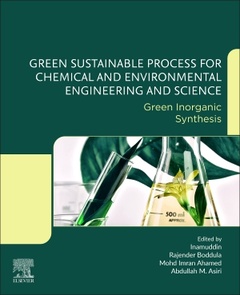Green Sustainable Process for Chemical and Environmental Engineering and Science Green Inorganic Synthesis
Coordonnateurs : Boddula Rajender, Ahamed Mohd Imran, Asiri Abdullah M., Inamuddin

Green Sustainable Process for Chemical and Environmental Engineering and Science: Green Inorganic Synthesis provides an in-depth review of the synthesis of inorganic materials utilizing green chemistry protocols. It summarizes the green synthesis methods used for the preparation, processing and development of inorganic materials. The methods for the synthesis of various inorganic materials includes microwaves, sonochemical, electrochemical, bioinspired, enzyme mediated, sol-gel, solid state, etc. It also includes green-solvents driven inorganic material synthesis using ionic liquids, supercritical fluids, plant-derived materials, and microorganisms. The content of this book provides useful information which may be used to inspire the readers to new synthetic routes for sustainable inorganic synthesis. This book brings together panels of highly-accomplished experts in the field of inorganic chemistry. It is a unique book, extremely well structured and essential resource for undergraduate, postgraduate students, faculty, R&D professionals, production chemists, environmental engineers, and industrial experts.
2. Microwave-assisted green synthesis of inorganic nanomaterials
3. Sonochemical synthesis of inorganic nanomaterials
4. Biosynthesis of inorganic nanomaterials
5. Green photosynthesis of inorganic nanomaterials
6. Green electrosynthesis of inorganic nanomaterials
7. Bioinspired synthesis of inorganic nanomaterials
8. Green synthesis of inorganic nanoparticle using microemulsion methods
9. Templated synthesis of inorganic nanomaterials
10. Enzyme-mediated synthesis of inorganic nanomaterials
11. Deep-eutectic solvents for inorganic nanomaterials synthesis
12. Polysaccharides for inorganic nanomaterials synthesis
13. Sol-gel synthesis of inorganic nanomaterials
14. Conversion of organic precursors to inorganic nanomaterials
15. Solid-state green synthesis of inorganic nanomaterials
16. Top-down and bottom-up approaches for inorganic materials synthesis
17. Ionic-liquid assisted synthesis of inorganic nanomaterials
18. Supercritical fluids for inorganic nanomaterials synthesis
19. Phytoextracts-mediated synthesis of inorganic nanomaterials
20. Synthesis of inorganic nanomaterials in aqueous medium
21. Synthesis of inorganic nanomaterials using carbohydrates
22. Deposition methods for inorganic nanomaterials
23. Synthesis of inorganic nanomaterials using microorganisms
24. Tailor-made synthesis of inorganic nanomaterials
25. Challenges and perspectives for inorganic green synthesis pathways
Dr. Mohd Imran Ahamed is a research associate in the Department of Chemistry, Faculty of Science, Aligarh Muslim University, Aligarh, and he has received his Ph.D on the topic “Synthesis and characterization of inorganic-organic composites heavy metals selective cation-exchangers and their analytical applications from Aligarh Muslim University India in 2019. He has published several research and review articles in SCI journals. His research focuses on ion-exchange chromatography, wastewater treatment and analysis, actuators, enzymatic biofuel cell, and electrospinning. Dr. Ahamed has published 18 research articles in international journals of repute, more than fifteen book chapters, and 20 published by renowned international publishers.
Prof. Abdullah M. Asiri is the Head of the Chemistry Department at King Abdulaziz University since October 2009 and he is the founder and the Director of the Center of Excellence for Advanced Materials Research (CEAMR) since 2010 till date. He is the Professor of Organic Photochemistry. His research interest covers color chemistry, synthesis of novel photochromic and thermochromic systems, synthesis of novel coloring matters and dyeing of textiles, materials chemistry, nanochemistry and nanotechnology, polymers and plastics. A major achievement of Prof. Asiri is the discovery of t
- Essential study guide for inorganic chemical synthesis
- Provides a broad overview of eco-friendly methods in inorganic synthesis
- Bestows the latest advances in inorganic synthetic protocols
- Provides key references and details in each synthesis technique/methods
- Outlines eco-friendly inorganic synthesis and chemical processes using microwave, sonochemical and solid-state techniques
Date de parution : 11-2020
Ouvrage de 298 p.
19x23.3 cm



